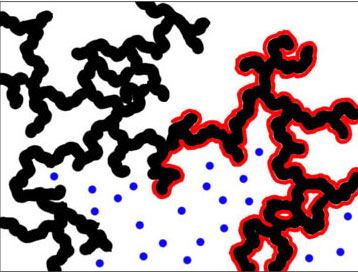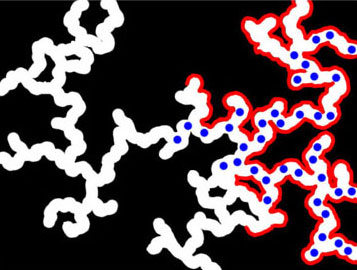Above: A solid can have a fractal surface in three different ways. In
a surface fractal (above) only the surface (red) is fractal.
Below: In a mass fractal, the solid (black) and the surface are
fractal.

In a pore fractal (below), the pore space (white) and the surface are
fractal.

Surface fractals and mass fractals have been known for a long time.
Scientists have now discovered the first case of a pore fractal. The
solid is carbon, and the fractal pore space forces molecules (blue
circles) to move along a fractal path. The fractal path amounts to
motion in a space with noninteger dimension. The molecules' continuous
contact with the wall makes them feel a very different environment than
if they were moving in the pore space of a surface fractal or mass
fractal.
Reported by: Pfeifer et
al., Physical Review Letters, 18 March 2002.
Associated
Physics News Update
Back to Physics News
Graphics
FRACTAL CARBON NANOPORE NETWORK.
Activated carbon, porous materials not unlike the charcoal used for
barbecuing, performs important industrial functions such as
filtering air, removing toxic vapors, and purifying our food and
beverages (e.g., sugar, molasses, vodka). For that reason, a far-
flung collaboration of scientists (the Universities of Missouri and
New Mexico, the CNRS lab in France, the Universidad de Alicante
in Spain, the Air Force Research Lab, and Los Alamos) set out to
learn more about the internal structure of the material. To their
surprise they discovered a fractal network of uniform channels,
what is perhaps the first documented pore fractal.
The researchers (contact Peter Pfeifer, pfeiferp@missouri.edu,
573-882-2335) take simple olive pits, "char" them (burn them
into
charcoal), and then treat them in steam at 750 C. How ironic that
in this case water, normally used to put out fire, here sustains
combustion by providing oxygen to burn with surface carbon.
What happens is not the removal of layer after layer or the carving
of holes of various sizes but instead the local etching and collapse
of pore walls to form channels of uniform size, about 2 nm wide.
This oxidation process will then abruptly branch in a new
direction. When it's all over the solid is riddled with a maze
governed by a fractal geometry. Scattering x rays from the
material establishes a "fractal dimension" of nearly 3,
meaning that
surface of the internal pore network practically fills all the inside
space.
The fractal nature of solid shapes has been measured
many
times, but this might be the first time a fractal mapping has been
performed for the empty space inside a void, namely the nanopore
network. (For comparison of pore, surface, and solid fractals, see
the figure at www.aip.org/mgr/png.)
The surface area of this great
inland realm works out to about 1000 square meters (or one
football field) per gram. The researchers expect that methane and
other fuels could be stored in this kind of structure (the molecules
are readily taken up into the branching alleyways by the weak
attraction of induced electric dipole "van der Waals" forces),
and at
pressures much less than the 200 atm needed to store methane in
steel cylinders. Gas separation can also be accomplished because
the narrow channels are negotiated more easily by some molecular
species than others. Electricity storage might be
accomplished by
building capacitors enhanced by intermediate layers of activated
carbon networks filled with an ionic conducting fluid. (Pfeifer et
al., Physical Review Letters, 18 March 2002).